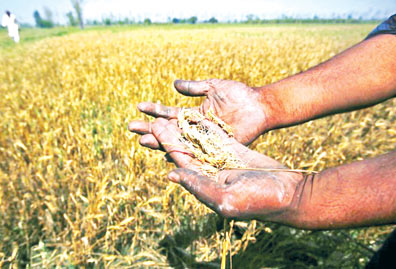Looking for ways to turn El Niño pain into gain
Amantha Perera
Rice farmer Weerasinghearchchilage Darmarathana is used to periodic
flooding in his low-lying village of Galella in central Sri Lanka.
 The 60-year-old has lived all his life on the flood plains of the
country's longest river, the Mahaweli, in Polonnaruwa District, some 250
km (155.34 miles) northeast of the capital Colombo. The 60-year-old has lived all his life on the flood plains of the
country's longest river, the Mahaweli, in Polonnaruwa District, some 250
km (155.34 miles) northeast of the capital Colombo.
"It used to be maybe twice, three times a year the road would go
under, but the last year has been insane," said the paddy farmer. In his
recollection, Galella has never been flooded with the same frequency as
in the last two months of 2015.
The village was hit six times in less than two months, Darmarathana
said, after unusually heavy rains battered the region in November and
December.
Over a million people were marooned in Sri Lanka's Northern, North
Central and Eastern Provinces, and over 400 homes and other buildings
were destroyed.
An advisory issued by the United Nations Economic and Social
Commission for Asia and the Pacific (ESCAP) in early December attributed
the rains to the current El Niño weather phenomenon, likely to be the
strongest since 1997-1998.
Extreme rainfall also caused havoc in India late last year, including
extensive flooding in the city of Chennai.
"The consensus that strong El Niño conditions has led to abnormal
rainfall during the northeast monsoon season in South Asia indicates
that El Niño had a part to play in the sequence of extreme weather
events in India," the ESCAP advisory said.
Excessive El Niño-linked rainfall across southern India and northern
Sri Lanka was expected to continue into early 2016, it added.
Sri Lankan authorities said they were prepared. "Historically El Niño
has meant more rains in this region, so we have been making our
predictions on those lines," said Lalith Chandrapala, head of the
island's Department of Meteorology.
Chandrapala said the country could be in a position to benefit from
the El Niño-induced rains, which began in mid-November on the back of a
weak monsoon he assessed to be 75 percent below average.
"We have been telling agencies like the Department of Agriculture to
advise farmers to prepare for rains," he said.
Changing Mindsets
The ESCAP report also noted that the waters from the current bout of
rains could be used for the upcoming planting season.
As the heavy rains struck when there was no harvest, agricultural
losses have been negligible.
Pradeep Koddiplili, deputy director at the Disaster Management
Centre, said no warnings had yet been issued for potential El
Niño-related crop damage, mainly because the rains had coincided with
the preparation of fields for planting.
But disaster risk experts working in rural areas say awareness of
changing weather patterns remains low and could prevent farmers making
the most of the unseasonal rains.
Sarath Wickramasinghe, a disaster risk reduction specialist with the
Sri Lanka Red Cross who works in North Central Province, said people in
the country's dry zone lacked sufficient infrastructure and knowledge to
adapt to shifting rains.
"They are traditionally geared for the monsoon, which comes twice a
year - even some officials are," he said. "That mindset needs to be
changed."
Farmers must adjust to long dry spells, like that experienced in
parts of Sri Lanka between June and October 2015, broken by heavy rains.
"Right now the cultivation cycles follow the traditional monsoon," he
added.
Farmer Darmarathana from Galella has worked according to the monsoon
since he started farming in the 1970s.
"I don't know any other timetable," he said. "Someone needs to teach
me the new methods, if there are any."
Wickramasinghe said the approach of traditional farmers needed to
evolve "if we are to gain any kind of advantage from the changing rain
patterns".
The Red Cross and the U.N. Development Programme have launched a
pilot project in Polonnaruwa District to help farmers adapt to uncertain
weather and climate conditions.
Targeting 100 families in Nagastenne village, it provides them with
assistance including seeds and technical knowledge to develop
sustainable agriculture methods, such as water harvesting, and to
restore degraded land.
- Thomson Reuters Foundation
|

